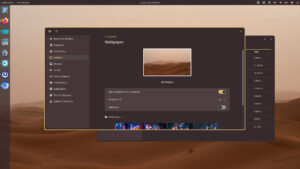It didn’t take nearly as long to count the votes for our desktop poll as it did for last week’s distro poll, mainly due to the fact that not as many of you voted, but also because there aren’t nearly as many desktop environments and window managers as their are Linux distros. Also, unlike the distro poll, there was a clear cut winner instead of a virtual tie.
 Actually, of course, it’s not about winners and losers. It’s about what you like. It’s about preferences. After all, unless you’re a diehard command line person, the desktop is how you interact with your computer.
Actually, of course, it’s not about winners and losers. It’s about what you like. It’s about preferences. After all, unless you’re a diehard command line person, the desktop is how you interact with your computer.
Again this year, KDE tops the list with a commanding lead, piling up over a quarter of the 617 votes cast. This is a huge drop from the 70 percent showing it made the last time we conducted a desktop poll, back in January and February of last year. In that poll, however, users were only given three desktop choices — KDE, GNOME 3 and Cinnamon. This year, voters were served up a menu that included eight popular desktops from which to choose. As in last year’s poll, voters could also opt to place write-in votes.
Why KDE? According to your comments, there were two major reasons: stability and configurability, with many of you saying, “It just works.” But there seemed to be some disagreement over whether KDE’s legendary configurability is as great as it once was.
“I use a slimmed-down KDE4 Plasma desktop for the same reason I use Gentoo, serious configurability/customizability,” wrote a reader named Duncan. “Though, unfortunately, KDE4 lost a lot of that configurability, that being the biggest reason I use a lot less KDE now than I did back in the KDE3 era.”
Not so fast, chimed in another reader with the handle Unbenkownst: “I don’t think KDE4 has less options than KDE3 — though that might really have been the case on the first versions, maybe up to KDE4.3.”
Xfice took second place, with nearly 18 percent of the vote. Although this strong showing might seem a little surprising to some, the use of this lightweight but conventional desktop has definitely been on the rise in recent years: compare this year’s 110 votes with last year’s 22 write-in votes for example.
“I had to go with Xfce, it has all the features I want,” wrote Don Cosner. “Other DE’s keep taking away and adding back features, but Xfce takes a conservative approach to development.” Others mentioned Xfce’s sparing use of system resources as being important to them.
From the looks of things, GNOME might finally be on something of a comeback after several years of declining use. A year ago, in a field of three, which should’ve worked to its advantage, the once most popular Linux desktop picked up less than six percent of the votes cast. This year, as one out of eight, it made an impressive third place showing with over fifteen percent of the vote. We’ll be interested in seeing if this is the beginning of a trend.
Although we only allowed voters to choose one desktop in the poll, many of you indicated that you use multiple desktops — sometimes on the same machine and often across many machines.
“Depends on what hardware I use,” wrote Abdel. “Unity and Gnome for powerful machines. Xfce for middle-range ones. LXDE, Enlightenment and Openbox for the less powerful ones.”
A regular commenter on FOSS Force, tracyanne, also uses multiple desktops. “I use Unity most; it’s on my primary laptop. My recording studio laptop runs Ubuntu Studio, so that’s Xfce, my media center runs Ubuntu with GNOME 3 Legacy, and finally, a spare machine runs Linux Mint with Cinnamon. My partner runs Xubuntu with, of course, Xfce,” she wrote, then added: “I guess FOSS Force dislikes Unity so much they won’t include it as an option.”
Oops! We forgot to include Unity as a poll answer — and many of you noticed.
“Seems odd you don’t have Unity on list,” wrote cmcanulty. Another reader, joncr, agreed: “Suggests either obvious error or obvious bias. Whatever the final result, a batch of trollers will use it to trumpet ‘Unity No One’s Favorite.'”
The omission was merely a mistake, and not meant as editorial commentary. When we realized what we’d done, we had a collective palm-to-face Homer Simpson “Doh!” moment, and a few of us even muttered the “S” word under our breaths. We apologize to the folks at Canonical and to all the folks who work and play using Ubuntu and the Unity desktop.
In spite of this omission, Unity did pretty good for itself as a write-in candidate. With 30 votes, it picked up more write-ins than any other desktop and took sixth place in our poll overall.
The poll also revealed that many of you opt to use window managers instead of full fledged desktop environments, as six separate window managers picked up a total of 33 votes.
| Desktop | Votes |
|---|---|
| KDE | 157 |
| Xfce | 110 |
| GNOME | 95 |
| Cinnamon | 83 |
| MATE | 56 |
| Unity | 30 |
| LXDE | 26 |
| *Fluxbox | 9 |
| Enlightenment | 8 |
| *Openbox | 8 |
| *i3 | 7 |
| Pantheon | 5 |
| *Awesome | 5 |
| *Window Maker | 3 |
| *xmonad | 2 |
| LXQt | 1 |
| Trinity | 1 |
| ROX | 1 |
Thanks to all of you for taking part. We’ll do it again next year.










Hi,
The comments on Gentoo by Duncan helped me view opportunities for extra trimming of KDE memory use.
These are some comparative results between KDE and Xfce of the “free” command taken right at the start of new sessions on a 1GB RAM PC:
KDE:
$ free
total used free shared buffers cached
Mem: 1021092 793560 227532 0 42864 429824
-/+ buffers/cache: 320872 700220
Swap: 2690880 0 2690880
$
Xfce:
$ free
total used free shared buffers cached
Mem: 1021092 720948 300144 0 43584 403736
-/+ buffers/cache: 273628 747464
Swap: 2690880 0 2690880
$
Not exactly a rigorous way to measure, but… as can be seen, things are getting somewhat similar.
Maybe Xfce still holds an advantage under 512MB RAM, though.
So why exactly did Suse kill kde in SLES12? Their argument that gnome is more popular is weak.
@kde_user
> So why exactly did Suse kill kde in SLES12? Their argument that gnome is more popular is weak.
Frankly, I never understood that either. KDE always has been the most used, except for that period of wars about KDE4 advancing so fast some of its users decided to jump off the wagon — Linus being the most emblematic of them.
For a time, then, Gnome was really the most popular.
A possible explanation is that most users don’t care about new interface paradigms or extreme configuration; for these, Gnome and its carefully polished “return to nothingness” might be enough for daily use.
I’m really not very qualified to answer that, I don’t use Gnome, Cinnammon and Mate seemed impossible to configure to the way I’m used in Xfce and KDE.
But it seems a weird, since SuSE (which I also don’t use) always seemed very close to the KDE guys.
Let us check Distrowatch… hmm… screenshots show SuSE indeed using something like Gnome 3 while OpenSuSE looks like it’s using KDE. That probably agrees with my copyrighted theory that ordinary people wanna have a more capable UI like KDE, while corporate users are subject to locked-down interfaces (that would explain Gnome, I suppose).
Excuse me for a while I don my fireproof vest…
I did not take part in this poll and i use GNome 3 so i dont believe the results are correct.
I didnt vote but KDE is by far the desktop we use most at home or families. XCFE is 2nd because we put it on some ancient machines.
Why KDE?
It works. I havent fiddled on my computer in 3-4yrs because I dont have time but also because I dont have to.
Whether Im using a rolling distro or have to upgrade an LTS every two years, I totally forget about the OS since the updates are automatic.
Why KDE over others?
Because its easier for Windows users who want to swithc and I do quite a few of those. Because it looks nicer. Because it has so many options to do what is the most important thing in a desktop: ALLOW IT TO LOOK LIKE I WANT. Because the user is always right.
You might not like super wide task bars or 16pt font or big buttons because you dont have bad eyesight but I just love having the desktop work the way I want i too.
Love the 4 virtual desktops and even have started to use Activities.
Love the native apps like Dolphin, Digikam, Calligra/Krita, Gwenview, Ksnap, Kate and Amarok which I think are exceptional.
Oh yeah, KDEnlive. Everyone at home uses it.
I use all kinds of desktops at work so Im not a fanatic about it but I like my desktops to work and look how I want them. I dont want someone telling me where the maximinize button HAS to go or that I cant have multiple windows open side by side or any of many things often we are told ‘have to be this way’.
Configurability is what allows this to happen. And once I configure it how I want, I dont touch it again for a long time so its not in the way.
As for various KDE distros, its really meaningless to me since their differences are usually esthetic and I change all those settings anyways. I can make any KDE distro work how I want it too and their differences are usually erased wehn i do.